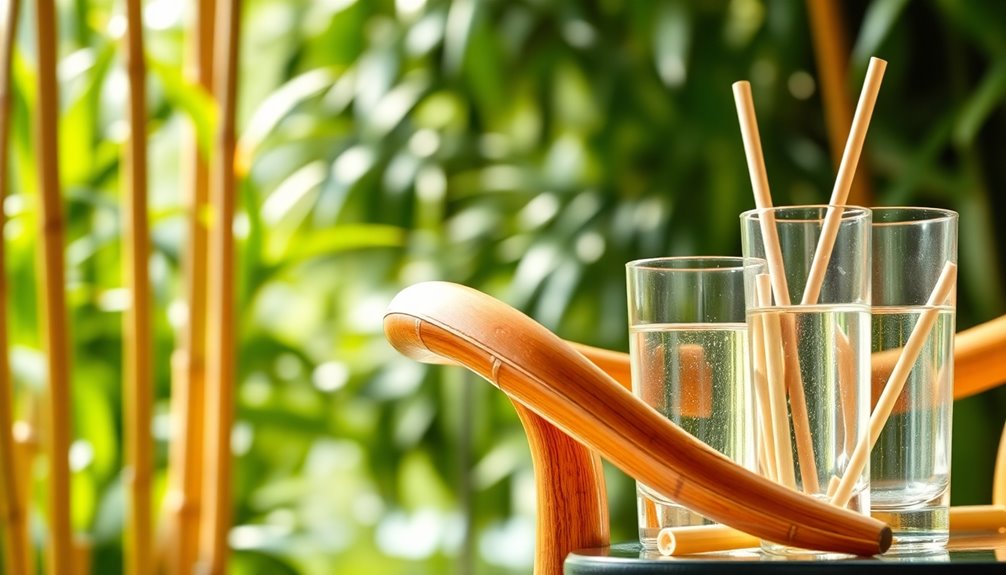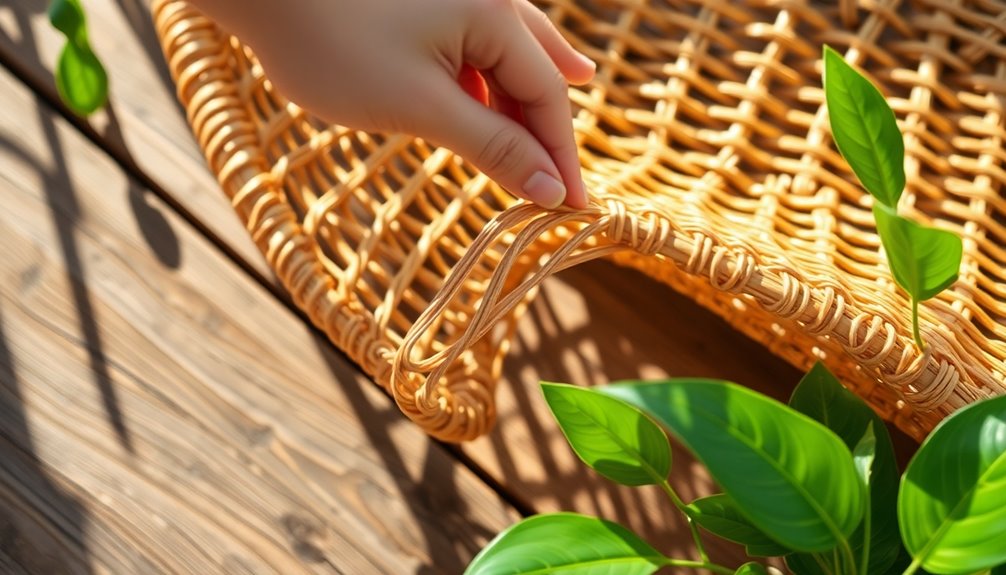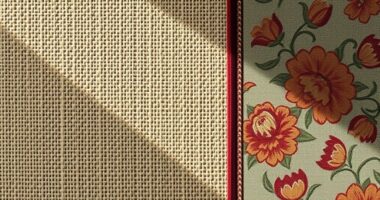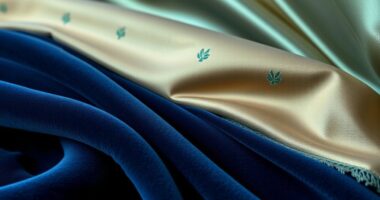If you're looking to incorporate eco-friendly materials into your designs, consider bamboo for its rapid growth and biodegradability. Rattan's lightweight and flexible nature makes it a favorite, while terrazzo shines with its durability and use of recycled materials. Polished plaster offers a non-toxic option with beautiful textures, and reclaimed wood adds unique character and history to any space. These materials not only enhance beauty but also support sustainable practices. Discover how each of these materials can elevate your projects and contribute to a greener planet.
Key Takeaways
- Bamboo: A fast-growing, biodegradable grass that requires minimal water and pesticides, making it a sustainable choice for eco-friendly designs.
- Rattan: This lightweight and flexible material is renewable and biodegradable, ideal for adding rustic charm while minimizing environmental impact.
- Terrazzo: A durable composite material made from recycled marble and glass, offering customizable designs with a long lifespan and minimal waste.
- Polished Plaster: Non-toxic finishes like Lime Wash enhance aesthetic appeal and are made from sustainable materials, while also improving energy efficiency.
- Reclaimed Wood: Sourced from old structures, this unique material reduces demand for new lumber and lowers carbon footprint, increasing property value.
Bamboo: The Versatile Choice

When it comes to eco-friendly materials for design, bamboo stands out as a versatile choice for both aesthetic appeal and functionality. As a fast-growing grass that reaches maturity in just three to five years, bamboo is one of the most rapidly renewable materials available. Its low energy production requirement means it uses considerably less water and pesticides compared to traditional hardwoods, leading to a lower environmental impact during cultivation.
You'll find bamboo perfect for various applications, from flooring to furniture and window treatments. Its natural resistance to pests and mold enhances its durability, making it suitable for indoor environments and contributing to the longevity of your designs.
Plus, you'll appreciate that bamboo is a biodegradable material, breaking down naturally at the end of its life cycle. This characteristic promotes sustainable design practices, reducing waste in the process.
Choosing bamboo not only elevates your design aesthetic but also aligns with environmentally conscious values. By incorporating bamboo into your projects, you support sustainable choices that reflect a commitment to both style and the planet's health.
Embrace bamboo, and you'll make a positive impact through your design work.
Rattan: Lightweight and Flexible

Rattan is a remarkable material that combines lightweight flexibility with sustainability, making it a favorite among designers. As a fast-growing, renewable resource, rattan isn't only eco-friendly but also incredibly versatile. You'll find it used in various applications, from stylish furniture to decorative wall cladding, enhancing the aesthetic appeal of any space.
One of the standout features of rattan is its biodegradability. When you choose rattan, you're contributing to sustainable practices in interior design by minimizing waste and reducing environmental impact. The harvesting process is gentle; rattan can be collected without harming the plant, allowing it to regenerate quickly. This means you can source it sustainably without depleting natural resources.
Rattan's unique patterns and textures bring a rustic charm to your designs, making it an exceptional choice for creating cozy and inviting living spaces. Whether you're designing a chic lounge chair or elegant decor elements, rattan's lightweight and flexible properties make it easy to work with, ensuring your creations are both stylish and environmentally responsible.
Embrace rattan in your next project and enjoy the perfect blend of beauty and sustainability.
Terrazzo: Durability With Style

Building on the theme of sustainable design, terrazzo emerges as a stunning choice that combines durability with style. This composite material incorporates recycled materials like marble scraps and glass chips, creating a visually appealing surface that's also environmentally friendly.
You'll appreciate its remarkable durability, as terrazzo can withstand heavy foot traffic, making it an ideal option for both commercial and residential spaces. Moreover, its production aligns with environmental innovations, as it utilizes materials that help reduce environmental impact. The use of recycled materials in terrazzo also underscores its eco-friendly credentials.
One of the standout features of terrazzo is its minimal waste production. By repurposing materials that would otherwise end up in landfills, it greatly reduces its environmental footprint. You can enjoy the beauty of terrazzo while knowing you're making a sustainable choice. Additionally, the process of creating terrazzo often involves natural resources that promote a healthier environment.
Customization is another key benefit; terrazzo allows you to create unique designs in various colors and patterns, catering to diverse aesthetics.
With a lifespan that can exceed 50 years, it not only enhances the beauty of your spaces but also contributes to sustainability by minimizing the need for replacement. Additionally, regular maintenance plans for terrazzo can help sustain its appearance and functionality over time.
In choosing terrazzo, you're investing in a long-lasting, stylish solution that reflects a commitment to both durability and environmental responsibility.
Polished Plaster: Aesthetic Appeal

While seeking ways to enhance your interior spaces, polished plaster offers an elegant solution that combines aesthetic appeal with eco-friendliness. This non-toxic option, featuring finishes like Lime Wash and Tadelakt, allows you to create visually striking surfaces that add depth and character to any room.
The unique textures and colors of polished plaster make it a favorite among designers, helping you craft spaces that aren't only beautiful but also healthy.
Moreover, polished plaster is made from sustainable materials, contributing to eco-friendly design practices. Its biodegradable nature means that when it's time for a change, it won't harm the environment.
You'll also appreciate its durability; polished plaster finishes provide a long-lasting solution that reduces the need for frequent repairs or replacements, aligning perfectly with sustainable design principles.
Additionally, polished plaster can enhance energy efficiency through natural thermal regulation, helping you maintain comfortable indoor temperatures. By utilizing materials like polished plaster, you are also supporting environmentally friendly practices that contribute to lower carbon footprints.
By choosing polished plaster, you're not just creating an aesthetically pleasing environment—you're also making a conscious choice for your health and the planet.
Embrace this beautiful, eco-friendly material to transform your spaces into something truly special.
Reclaimed Wood: Rich History

Embracing reclaimed wood not only adds a unique character to your designs but also connects you to a rich history that new materials simply can't replicate. Sourced from old buildings, barns, and other structures, reclaimed wood carries stories and charm that enhance any project.
By choosing this sustainable, natural material, you're actively reducing the demand for new lumber, which helps minimize deforestation and preserves essential habitats.
The high-quality, dense timber found in reclaimed wood has naturally aged over time, giving it a distinct aesthetic that's highly sought after for furniture and flooring.
Plus, incorporating this material into your designs can greatly lower your project's carbon footprint. By recycling wood that would otherwise contribute to landfill waste, you're making a positive choice for the environment.
Beyond its aesthetic and environmental benefits, using reclaimed wood can also increase property value. Many buyers are drawn to the sustainability and unique character it adds to a home. Furthermore, incorporating high-quality content into your marketing strategies can enhance your project's visibility and appeal in the competitive design industry.
Frequently Asked Questions
What Are Examples of Eco-Friendly Designs?
When it comes to eco-friendly designs, you're really hitting the nail on the head!
Think of bamboo furniture that's not only stylish but also sustainable. Reclaimed wood adds character while reducing waste, and terrazzo gives you a unique touch with its recycled materials.
Don't forget cork for flooring or insulation, and natural fibers like jute and hemp for textiles.
These choices not only look great but also help our planet, making your space truly special.
What Material Is More Eco-Friendly?
When you're deciding which material is more eco-friendly, consider bamboo, reclaimed wood, cork, mycelium leather, and algae bioplastic.
Bamboo grows rapidly and can be harvested sustainably, while reclaimed wood reduces waste and deforestation.
Cork is harvested without harming trees, allowing them to continue absorbing CO2.
Mycelium leather offers a lower environmental impact than traditional leather, and algae bioplastic is a renewable option that captures carbon.
Each choice contributes positively to the environment.
What Is the Most Environmentally Friendly Building Material?
When you're considering the most environmentally friendly building material, bamboo often tops the list. It grows rapidly, needs minimal resources, and can be harvested sustainably.
Reclaimed wood is another strong contender, reducing the need for new lumber and cutting down on deforestation.
Don't overlook cork, either; it's harvested without harming the trees, allowing them to continue absorbing carbon.
Each material has its benefits, so think about your specific project when making a choice.
What Makes a Design Eco-Friendly?
Imagine a home bathed in sunlight, where fresh air flows freely, contrasting with dark, stuffy spaces filled with toxins.
An eco-friendly design prioritizes natural materials, energy efficiency, and non-toxic finishes. You’ll notice how these choices boost indoor air quality and create a healthier environment. When considering furniture and decor, sustainable home design ideas focus on upcycling or using recycled materials. Additionally, incorporating energy-efficient appliances and incorporating greenery into the living space are other ways to enhance the eco-friendly design. Ultimately, making these choices not only benefits the environment but also contributes to a more comfortable and peaceful living space.
By incorporating renewable resources and biophilic elements, you not only enhance aesthetics but also embrace a lifestyle that nurtures both you and the planet.
It's a beautiful balance of form and function.









